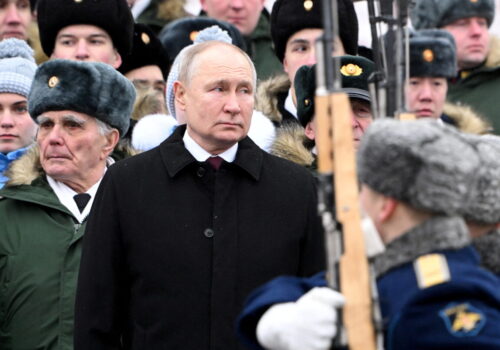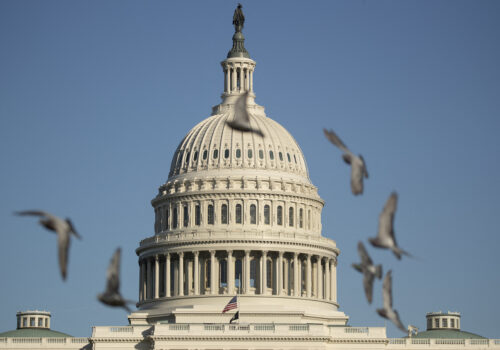Renewed US assistance opens a path to success, if Ukraine’s friends move fast
“There was always just enough virtue in this Republic to save it; sometimes none to spare.”
—William Seward
Finally, the blockage imposed by a minority of “America First” House members has been broken and, after a six-month delay, crucial US military aid may be on its way to Ukraine again. An alliance of what might be termed Reaganite Republicans and Trumanesque Democrats—a coalition that helped bring success in the Cold War and after—passed a $60.8 billion assistance package for Ukraine in 311-112 vote on Saturday. Rapid acceptance by the Senate and signature by US President Joe Biden look likely to follow in short order. The Biden administration appears poised to push ahead fast with sending new weapons to Ukraine.
The House vote stops the hemorrhage of US credibility that had thrown US allies into varying degrees of alarm and demoralized Ukrainians, who are fighting for their lives. Meeting with me and US colleagues in Kyiv in late March, a senior Ukrainian government official asked rhetorically what had become of the United States on which Ukraine has pinned its hopes for survival and freedom. Katarzyna Pisarska, head of the Casimir Pulaski Foundation and one of Poland’s most effective foreign policy experts, who led a group of Polish, German, and French parliamentarians to Washington in the days before the vote, put it bluntly: “We believe in America. Watching the paralysis in the face of [Russian President Vladimir] Putin’s aggression shook us all. Passage of the assistance restores our faith.”
The House vote stops the hemorrhage of US credibility that had thrown US allies into varying degrees of alarm and demoralized Ukrainians.
“Ukraine has not yet perished” are the opening words of the Ukrainian national anthem. They remain true. The Biden administration should take the successful vote on US assistance to Ukraine as an opportunity to reverse the perception, advanced by Kremlin propagandists and their friends, that Ukraine is doomed. In fact, with sufficient European and US support, Ukraine has a plausible path to success in the war.
As US government officials put it, with enough shells (especially from the multination initiative led by the Czech Republic) the Ukrainian military could blunt an expected Russian land offensive. With sufficient new air-defense systems (including from a German-led effort), the Ukrainians could limit the damage Russian strikes do to their infrastructure and cities. Using long-range weapons, Ukraine could further degrade Russian bases, supply lines, and even its hold on Crimea. An intensified flow of US weapons, including the longer-range Army Tactical Missile System (or ATACMS), which the House bill presses for by name, could shift battlefield fortunes. The Biden administration should set aside its ill-considered opposition to Ukrainian strikes on legitimate targets inside Russia. With more and better weapons and fewer restrictions, Russian casualties and damage could mount and opposition to the war, latent but evident inside Russia, could grow.
A surge of weapons to Ukraine needs to be accompanied by an uptick in sanctions on Russia. The US- and European-led sanctions effort was effective in the first year of the full Russian invasion but needs to be intensified to close loopholes and go after third countries and companies that help Russia evade sanctions. The Group of Seven (G7) debate about using the roughly $300 billion of immobilized Russian sovereign assets held in Western financial institutions to help Ukraine has only crawled forward, at a pace not commensurate with the stakes. The legal case for using those assets to help Ukraine appears solid. The G7 Summit this coming June should be a moment for action, not further discussion.
The Biden administration and European allies must lean forward on assistance for Ukraine across the board.
If the United States and its allies surge ahead in military support for Ukraine and new economic pressure on Russia, by the time of the July NATO Summit in Washington Ukraine’s battlefield fortunes could be better and Russia on the defensive militarily and economically. The Biden administration appears intent on using that summit to lock in robust security support to Ukraine through a series of parallel agreements by European allies and the United States, a sort of bridge to ultimate NATO membership, as administration officials privately put it. The metaphor is apt: A credible bridge from Ukraine’s wartime trial to the long-term security of NATO membership—an end state that NATO has already agreed on—would be a major success and a marked setback for Putin.
But that’s a best-case scenario. The six-month delay in the assistance package caused by a determined isolationist minority in the House has cost Ukraine many lives and much damage. Numerous reports describe a deteriorating military situation on the front lines and Russian preparations for a major land offensive. The memory of the United States dithering while Ukraine literally burned, and the arguments of the America Firsters that effectively signaled that Ukraine was unimportant and should be left to Russia, will linger.
The vote came through in the end. Governments around the world nevertheless may start hedging against the next resurgence of US isolationism and the next demonstration of unreliability. Russia and China will exploit the display of US political paralysis. Pro-Donald Trump authoritarians like Hungary’s Viktor Orban may argue, as did their predecessors during World War II, that democracy is finished and the future belongs to them.
To avoid the worst outcomes and capitalize on the good news of a successful vote, the Biden administration and European allies must lean forward on assistance for Ukraine across the board.
Daniel Fried is the Weiser Family distinguished fellow at the Atlantic Council, former US ambassador to Poland, and former US assistant secretary of state for Europe.
Further reading
Fri, Apr 12, 2024
Dispatch from Kyiv: Ukraine is fighting for its economic survival, too
New Atlanticist By Olga Khakova, Charles Lichfield
The longer the war lasts, the more it will consume funds initially meant for long-term investments and reconstruction.
Tue, Apr 16, 2024
Western fear of escalation will hand Putin an historic victory in Ukraine
UkraineAlert By Mykola Bielieskov
The West’s self-defeating fear of escalation has allowed Russia to regain the initiative in Ukraine and is now threatening to hand Putin an historic victory, writes Mykola Bielieskov.
Sat, Apr 20, 2024
The House passed Ukraine aid at last. Here’s what it means.
Fast Thinking By
After months of costly delays, new shipments of US military aid look set to head to Ukraine soon. Our experts weigh in on next steps from Washington, Kyiv, and the EU.
Image: REUTERS/Sofiia Gatilova


